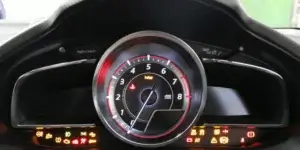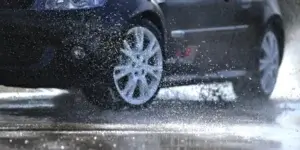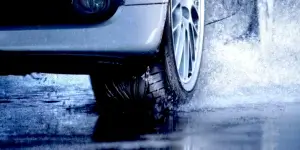What is traction control and how does it function?
Traction control is one of those terms you might have heard thrown around at the car dealership or seen flicker on your dashboard, but what exactly is it?
In essence, traction control is a sophisticated safety system designed to prevent wheelspin and help your car maintain grip on the road. If you’ve purchased a car made since 2014, you can be sure it includes this feature, thanks to legal requirements. But even before then, many cars had this handy tool as part of their safety arsenal. From urban streets to winding country roads, it works discreetly to boost your confidence in less-than-perfect conditions by collaborating with other car safety features.

How does traction control work and when is it activated?
Let’s break it down without getting too technical—traction control employs sensors to detect any slippage or loss of grip between your tyres and the road surface, especially when accelerating. If the car’s electronic control unit (ECU) senses a wheel spinning faster than the speed of the vehicle, it swiftly reduces engine power to the wheel, regaining its grip. This process occurs seamlessly without requiring any driver input, although you’ll notice the traction control light blinking on your dashboard when it’s working. This light is your car’s subtle way of saying, “”I’ve got this,”” as it helps you glide safely along the road.
What are the benefits of having traction control?
The primary advantage of traction control is its ability to enhance your tyres’ grip when accelerating. Without it, wheelspin can occur, which means your tyres aren’t gripping the road properly, potentially leading to a loss of control. Imagine trying to pull out of a junction swiftly, only to find your car isn’t responding as you’d like. Traction control works in tandem with other systems to ensure your vehicle remains stable and under control, even when conditions are less than ideal. This makes pulling away from traffic lights or navigating a slippery roundabout a much safer experience.

Is traction control a crucial safety feature in cars?
Absolutely! Traction control is a key player among a suite of driver-assistance safety features in modern cars. While it specifically addresses wheelspin during acceleration, it works alongside systems like electronic stability control (ESC) to help maintain overall vehicle stability. ESC, or electronic stability programme (ESP), takes it a step further by reducing the risk of skids when your car slides across the road surface. Together, these systems form a cohesive safety net, ensuring you remain in control, even in challenging driving conditions.
For more information about car safety features, check out our car safety features guide.
Do all vehicles come equipped with traction control?
In today’s landscape, most cars are equipped with traction control. While it was available in some vehicles as far back as the 1980s, it became a standard feature in many cars by the late 1990s. Traction control became mandatory for all new cars in the European Union from 2014 onwards. However, there are some exceptions, such as low-volume vehicles manufactured by niche brands like Caterham Cars, where traction control might not be a standard offering.
What’s the distinction between traction control and electronic stability control?
Picture traction control as your trusty co-pilot, ensuring your tyres grip the road during acceleration. On the other hand, electronic stability control (ESC) is like having a seasoned navigator by your side. While traction control focuses on preventing wheelspin, ESC takes a holistic approach to maintaining vehicle stability, particularly when cornering or navigating tricky surfaces. By using sensors and computer algorithms, ESC can apply brakes to individual wheels and adjust engine power output, helping you regain control during a potential skid. This dynamic duo of traction control and ESC significantly enhances your driving confidence.

How can you tell if traction control is active?
Ever wondered how you’ll know if traction control is lending a helping hand? It’s quite straightforward. When the system activates, the traction control light on your dashboard will flash momentarily. You might also notice a slight dip in engine power as it works its magic to restore grip. This subtle interaction often occurs when you apply the accelerator pedal aggressively, such as when accelerating from a standstill at traffic lights.
When should traction control be used in a car?
The beauty of traction control lies in its autonomy—it’s always at the ready, working to keep you safe. You don’t need to consciously activate it; it’s enabled by default each time you start your car. You’re most likely to experience its assistance in adverse weather conditions, such as rain, ice, or snow, or when driving on slippery surfaces. However, if you notice the traction control system engaging more frequently, it might be worth checking your tyres for signs of wear.
Learn more about tyre maintenance with our car maintenance guide.
Can you turn off traction control in your vehicle?
While driving without traction control engaged isn’t recommended, there might be rare instances where turning it off suits your needs. For example, if you encounter a thin layer of ice, sand, or wet mud, allowing a bit of wheelspin could actually help you gain traction. In such cases, you can typically switch off the system by pressing a button labeled TCS or TC, or by navigating through menus on your touchscreen infotainment system. Keep in mind that this should be a temporary measure, as traction control is designed to enhance your safety.

What does the traction control light indicate?
The traction control light serves as a friendly indicator, letting you know that the system is operational. When you start your engine, the light will briefly illuminate to confirm that traction control is functioning. If it stays on after start-up, it could signal a fault that requires attention from a professional. A flashing light while driving indicates that the system is actively working, which is typically expected on slippery roads. However, if the light persists even on dry surfaces, it’s wise to have it checked.
Should you drive with the traction control light on?
While it’s possible to drive with the traction control light illuminated, it’s advisable to have your system inspected sooner rather than later. Driving with the light on could mean you’re lacking an essential safety net, particularly on slippery roads. To ensure your peace of mind and optimal vehicle performance, consult a garage to diagnose and address any potential issues.
Final Thoughts
Traction control may operate silently in the background, but its impact on your driving experience is profound. By preventing wheelspin and maintaining stability, it plays a crucial role in keeping you safe on the road. From wet city streets to icy rural lanes, traction control empowers you with confidence and control. Remember, this technology is just one of many tools at your disposal to enhance your driving safety.
For more insights, explore our comprehensive guides on car safety features and driving tips.


